Deep-Asymmetry: Asymmetry Matrix Image for Deep Learning Method in Pre-Screening Depression
Abstract
:1. Introduction
2. Materials and Methods
2.1. Dataset
2.2. Data Preprocessing
2.3. Visualizing EEG Image of Brain Asymmetry
2.4. Classification Model
2.5. Evaluation
3. Results
3.1. Visualized EEG Image of Brain Asymmetry
3.2. Classification Model
4. Discussion
5. Conclusions
Supplementary Materials
Author Contributions
Funding
Conflicts of Interest
References
- Depression. Available online: https://www.who.int/news-room/fact-sheets/detail/depression (accessed on 7 September 2020).
- Parekh, R. What Is Depression? Available online: https://www.psychiatry.org/patients-families/depression/what-is-depression (accessed on 7 September 2020).
- Smith, K.M.; Renshaw, P.F.; Bilello, J. The diagnosis of depression: Current and emerging methods. Compr. Psychiatry 2013, 54, 1–6. [Google Scholar] [CrossRef] [PubMed] [Green Version]
- Psychiatric, A. Association. In Diagnostic and Statistical Manual of Mental Disorders, 5th ed.; American Psychiatric Association: Washington, DC, USA, 2013. [Google Scholar] [CrossRef]
- Brenner, L.A. Beck Anxiety Inventory. In Encyclopedia of Clinical Neuropsychology; Springer New York: New York, NY, USA, 2011; pp. 359–361. [Google Scholar]
- Williams, J.B.W. A Structured Interview Guide for the Hamilton Depression Rating Scale. Arch. Gen. Psychiatry 1988, 45, 742–747. [Google Scholar] [CrossRef] [PubMed]
- Shetty, P.; Mane, A.; Fulmali, S.; Uchit, G. Understanding masked depression: A Clinical scenario. Indian J. Psychiatry 2018, 60, 97. [Google Scholar] [CrossRef] [PubMed]
- Eberhard, G. Masked depression—History, diagnosis and delimitation. Nord. Psykiatr. Tidsskr. 1989, 43, 7–13. [Google Scholar] [CrossRef]
- Łojko, D.; Rybakowski, J.K. Atypical depression: Current perspectives. Neuropsychiatr. Dis. Treat. 2017, 13, 2447–2456. [Google Scholar] [CrossRef] [PubMed] [Green Version]
- Park, J.-I.; Jeon, M. The Stigma of Mental Illness in Korea. J. Korean Neuropsychiatr. Assoc. 2016, 55, 299–309. [Google Scholar] [CrossRef] [Green Version]
- de Aguiar Neto, F.S.; Rosa, J.L.G. Depression biomarkers using non-invasive EEG: A review. Neurosci. Biobehav. Rev. 2019, 105, 83–93. [Google Scholar] [CrossRef]
- Mumtaz, W.; Xia, L.; Ali, S.S.A.; Yasin, M.A.M.; Hussain, M.; Malik, A.S. Electroencephalogram (EEG)-based computer-aided technique to diagnose major depressive disorder (MDD). Biomed. Signal Process. Control 2017, 31, 108–115. [Google Scholar] [CrossRef]
- Mahato, S.; Paul, S. Classification of Depression Patients and Normal Subjects Based on Electroencephalogram (EEG) Signal Using Alpha Power and Theta Asymmetry. J. Med Syst. 2019, 44, 28. [Google Scholar] [CrossRef]
- Mahato, S.; Paul, S. Detection of major depressive disorder using linear and non-linear features from EEG signals. Microsyst. Technol. 2019, 25, 1065–1076. [Google Scholar] [CrossRef]
- Allen, J.J.B.; Reznik, S.J. Frontal EEG asymmetry as a promising marker of depression vulnerability. Summ. Methodol. Consid. 2015, 4, 93–97. [Google Scholar] [CrossRef] [Green Version]
- Dharmadhikari, A.S.; Tandle, A.L.; Jaiswal, S.V.; Sawant, V.A.; Vahia, V.N.; Jog, N. Frontal Theta Asymmetry as a Biomarker of Depression. East Asian Arch. Psychiatry 2018, 28, 17–22. [Google Scholar] [PubMed]
- Acharya, U.R.; Oh, S.L.; Hagiwara, Y.; Tan, J.H.; Adeli, H.; Subha, D.P. Automated EEG-based screening of depression using deep convolutional neural network. Comput. Methods Programs Biomed. 2018, 161, 103–113. [Google Scholar] [CrossRef] [PubMed]
- Mumtaz, W.; Qayyum, A. A deep learning framework for automatic diagnosis of unipolar depression. Int. J. Med Inform. 2019, 132, 103983. [Google Scholar] [CrossRef] [PubMed]
- Ay, B.; Yildirim, O.; Talo, M.; Baloglu, U.B.; Aydin, G.; Puthankattil, S.D.; Acharya, U.R. Automated Depression Detection Using Deep Representation and Sequence Learning with EEG Signals. J. Med. Syst. 2019, 43, 205. [Google Scholar] [CrossRef]
- Wajid, M. MDD Patients and Healthy Controls EEG Data (New). 2016. Available online: https://figshare.com/articles/EEG_Data_New/4244171 (accessed on 15 November 2020). [CrossRef]
- Klem, G.H.; Lüders, H.O.; Jasper, H.H.; Elger, C. The ten-twenty electrode system of the International Federation. The International Federation of Clinical Neurophysiology. Electroencephalogr. Clin. Neurophysiol. Suppl. 1999, 52, 3–6. [Google Scholar]
- Jung, T.-P.; Makeig, S.; Humphries, C.; Lee, T.-W.; McKeown, M.J.; Iragui, V.; Sejnowski, T.J. Removing electroencephalographic artifacts by blind source separation. Psychophysiology 2000, 37, 163–178. [Google Scholar] [CrossRef]
- Durongbhan, P.; Zhao, Y.; Chen, L.; Zis, P.; Marco, M.D.; Unwin, Z.C.; Venneri, A.; He, X.; Li, S.; Zhao, Y.; et al. A Dementia Classification Framework Using Frequency and Time-Frequency Features Based on EEG Signals. IEEE Trans. Neural Syst. Rehabil. Eng. 2019, 27, 826–835. [Google Scholar] [CrossRef] [Green Version]
- Chao, H.; Dong, L.; Liu, Y.L.; Lu, B.Y. Emotion Recognition from Multiband EEG Signals Using CapsNet. Sensors 2019, 19, 2212. [Google Scholar] [CrossRef] [Green Version]
- Hinrikus, H.; Suhhova, A.; Bachmann, M.; Aadamsoo, K.; Võhma, Ü.; Lass, J.; Tuulik, V. Electroencephalographic spectral asymmetry index for detection of depression. Med. Biol. Eng. Comput. 2009, 47, 1291. [Google Scholar] [CrossRef]
- Welch, P. The use of fast Fourier transform for the estimation of power spectra: A method based on time averaging over short, modified periodograms. IEEE Trans. Audio Electroacoust. 1967, 15, 70–73. [Google Scholar] [CrossRef] [Green Version]
- Weisstein, E.W. Simpson’s Rule. Available online: https://mathworld.wolfram.com/SimpsonsRule.html (accessed on 7 September 2020).
- Ioffe, S.; Szegedy, C. Batch Normalization: Accelerating Deep Network Training by Reducing Internal Covariate Shift. arXiv 2015, arXiv:1502.03167. [Google Scholar]
- Srivastava, N.; Hinton, G.; Krizhevsky, A.; Sutskever, I.; Salakhutdinov, R. Dropout: A simple way to prevent neural networks from overfitting. J. Mach. Learn. Res. 2014, 15, 1929–1958. [Google Scholar]
- Masters, D.; Luschi, C. Revisiting Small Batch Training for Deep Neural Networks. arXiv 2018, arXiv:1804.07612. [Google Scholar]
- Kingma, D.P.; Ba, J. Adam: A Method for Stochastic Optimization. arXiv 2015, arXiv:1412.6980. [Google Scholar]
- Stone, M. An Asymptotic Equivalence of Choice of Model by Cross-Validation and Akaike’s Criterion. J. R. Stat. Soc. Ser. B 1977, 39, 44–47. [Google Scholar] [CrossRef]
- Aslan, Z.; Akin, M. Automatic Detection of Schizophrenia by Applying Deep Learning over Spectrogram Images of EEG Signals. Traitement Signal 2020, 37, 235–244. [Google Scholar] [CrossRef]
- Li, X.; La, R.; Wang, Y.; Hu, B.; Zhang, X. A Deep Learning Approach for Mild Depression Recognition Based on Functional Connectivity Using Electroencephalography. Front. Neurosci. 2020, 14. [Google Scholar] [CrossRef] [Green Version]
- Saeedi, A.; Saeedi, M.; Maghsoudi, A.; Shalbaf, A. Major depressive disorder diagnosis based on effective connectivity in EEG signals: A convolutional neural network and long short-term memory approach. Cogn. Neurodyn. 2020. [Google Scholar] [CrossRef]

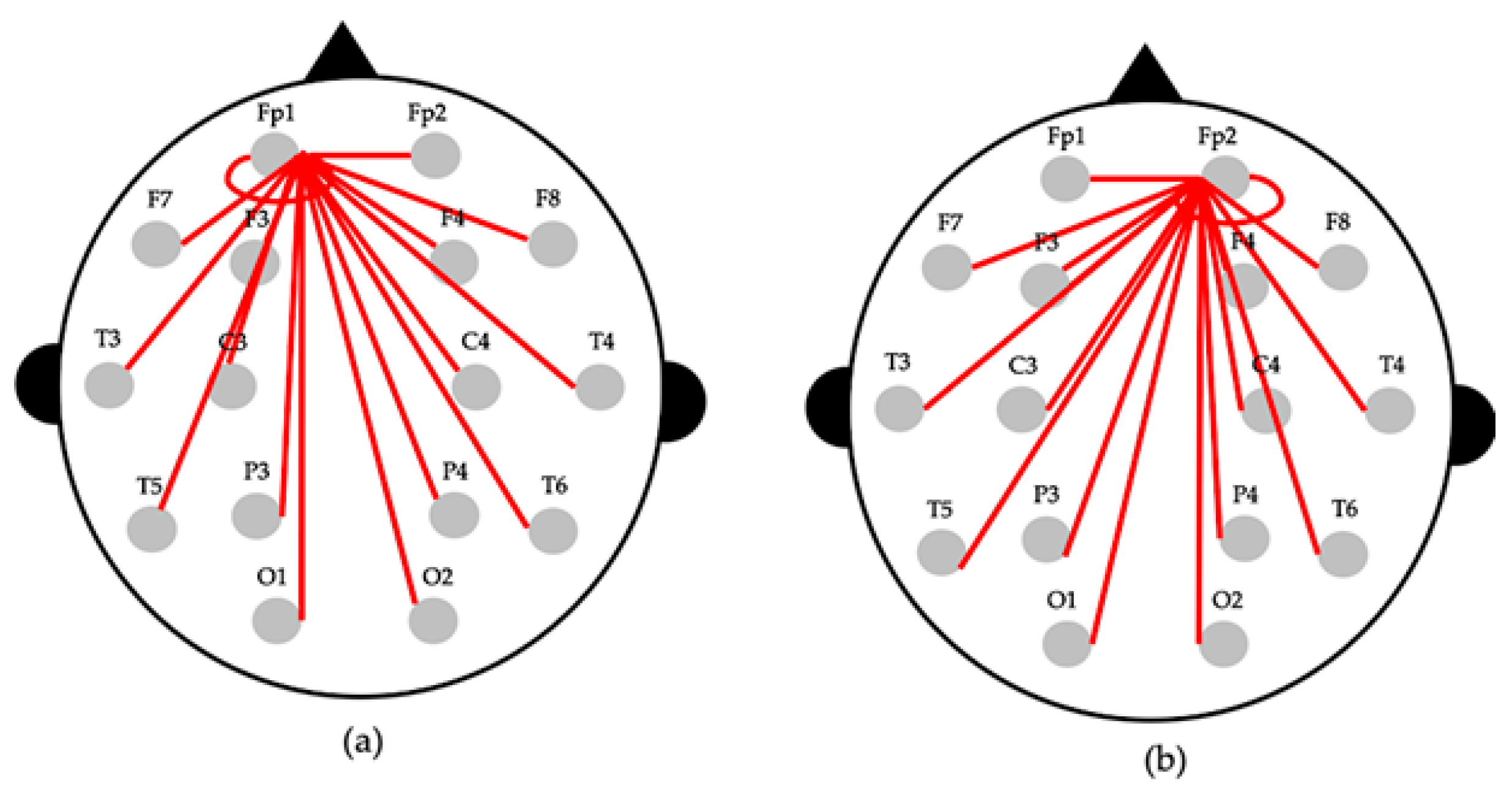

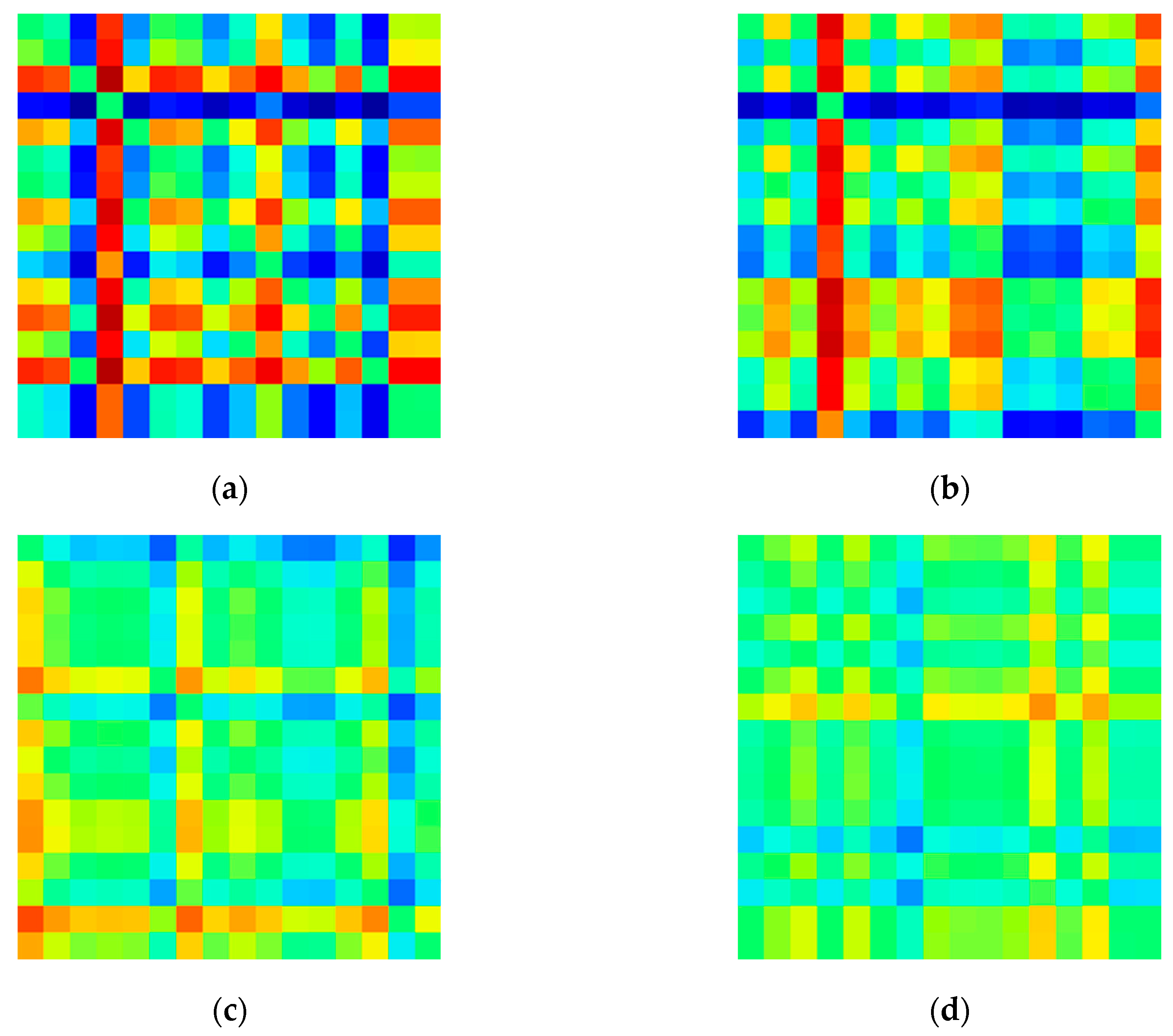
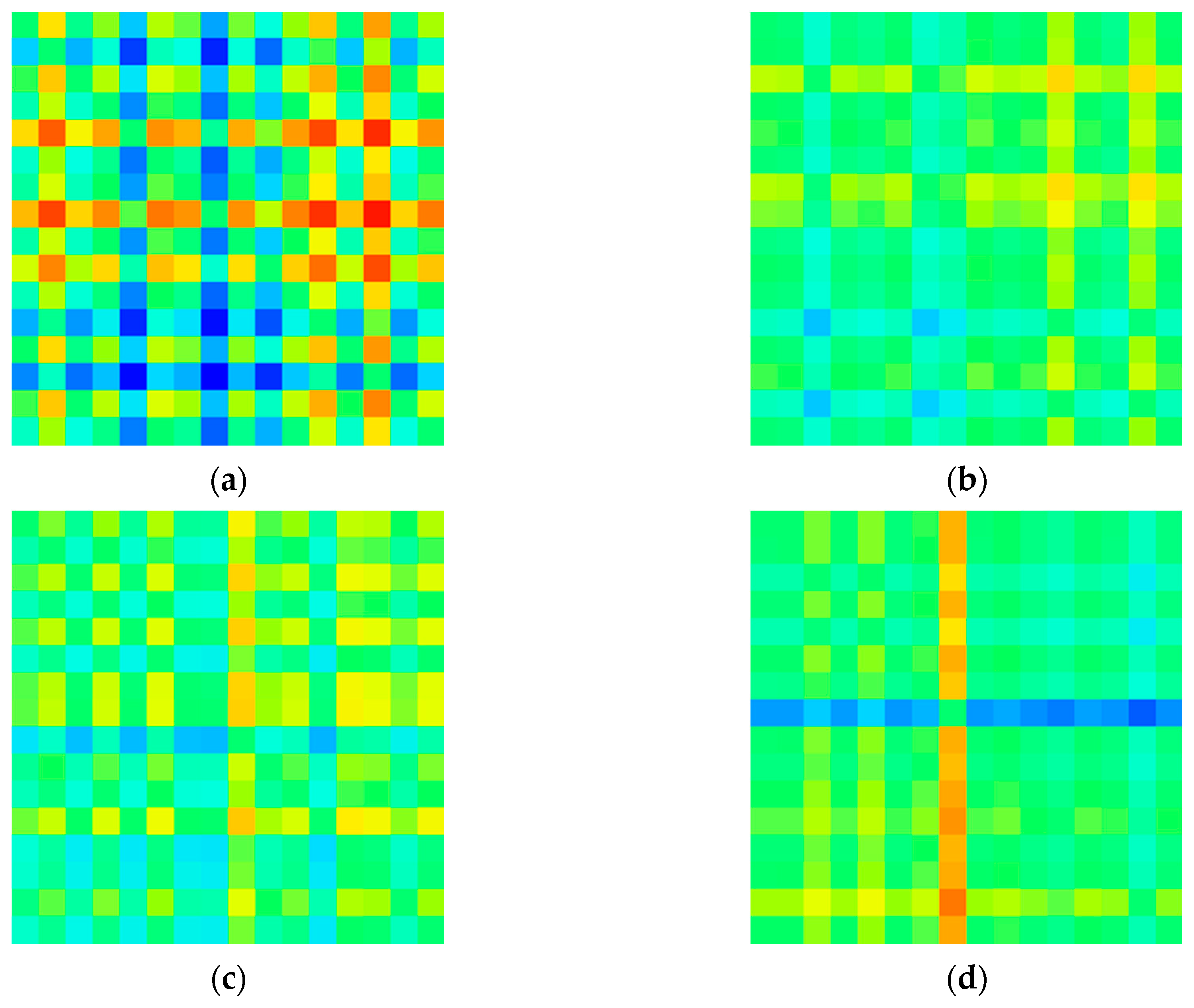

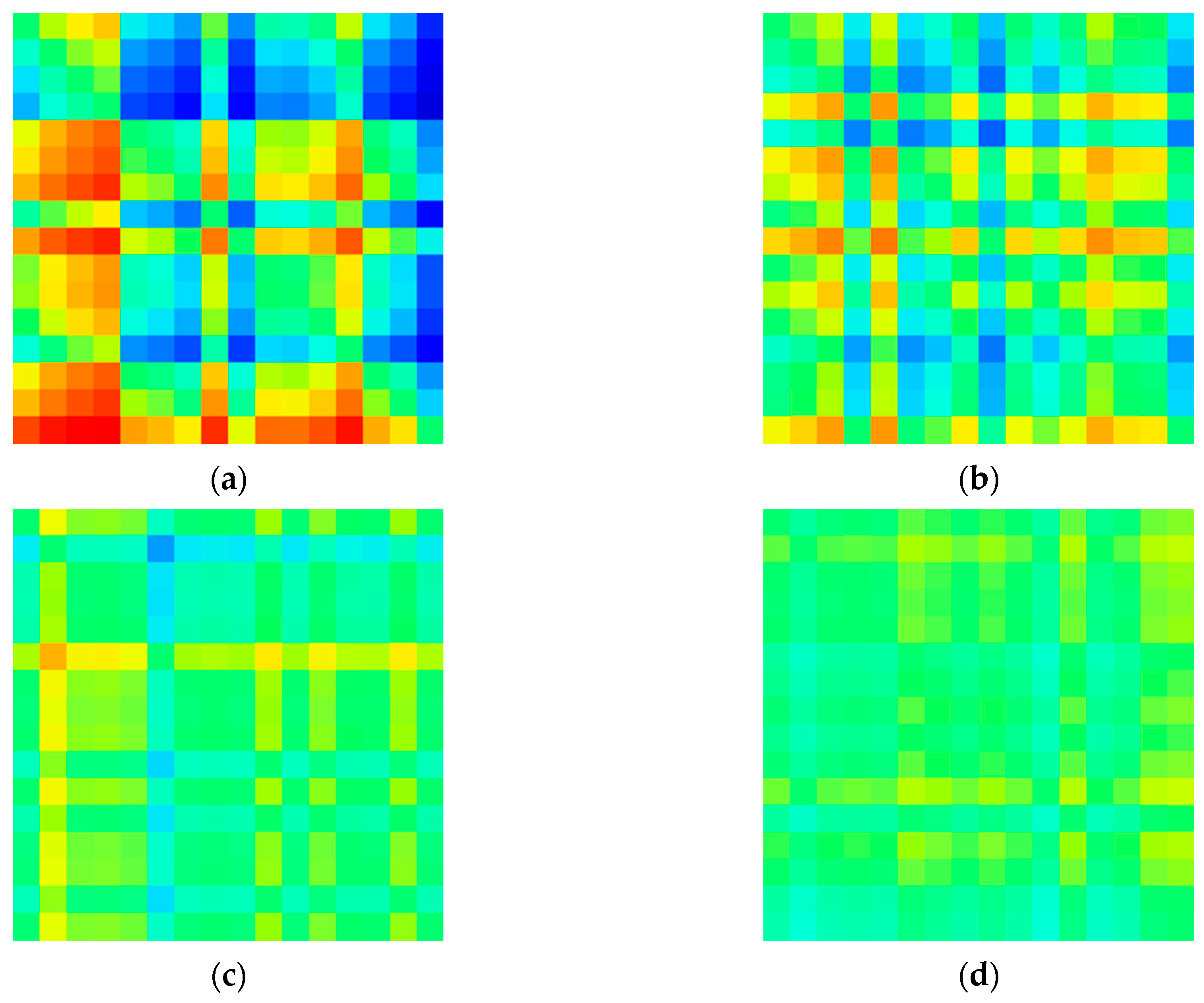

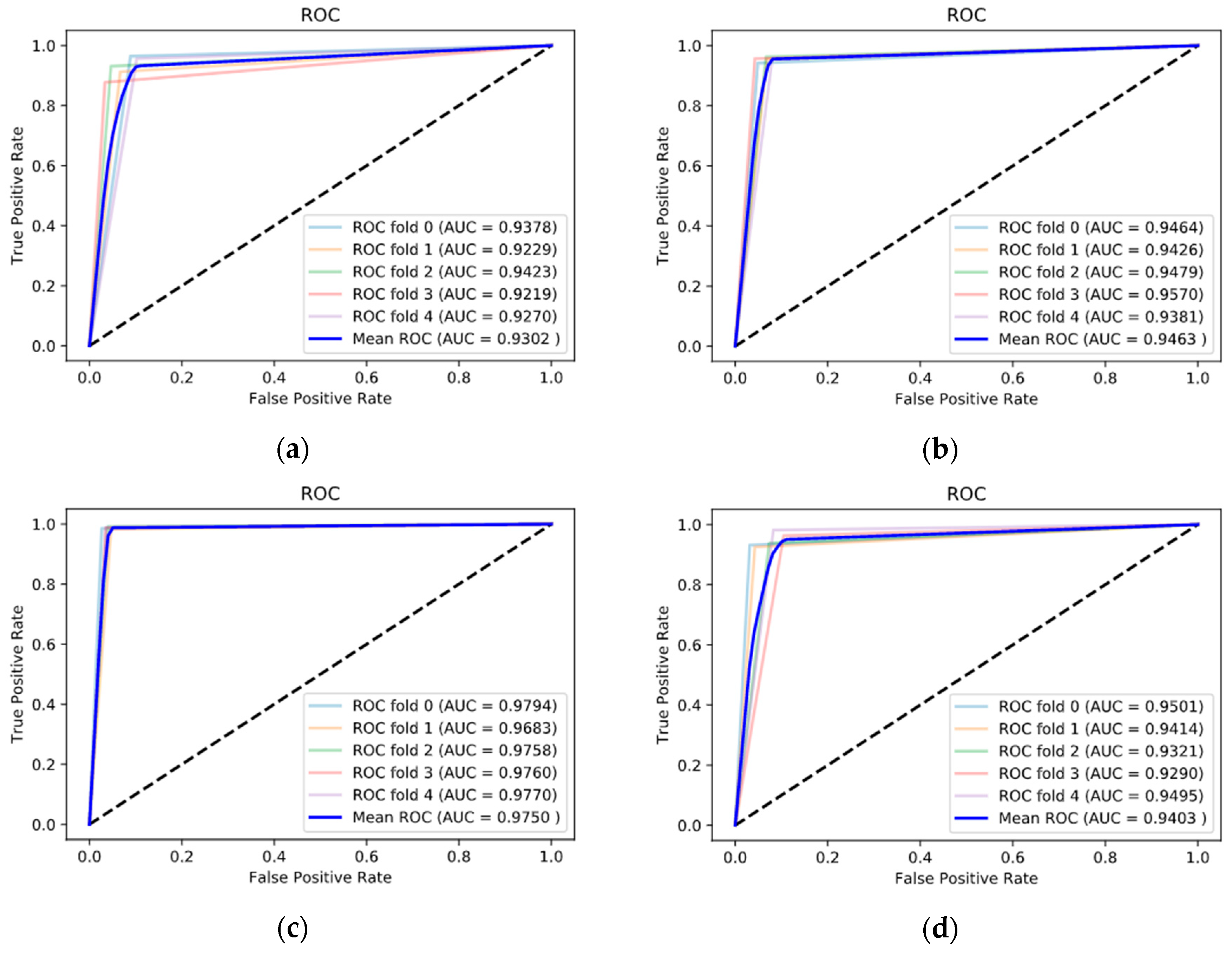
| Layer | Output Shape | Param # |
|---|---|---|
| Input | 64, 64, 3 | - |
| 2D Convolution (C1) | 62, 62, 32 | 896 |
| 2D Maxpooling (P1) | 31, 31, 32 | 0 |
| Batch normalization (BN) | 31, 31, 32 | 128 |
| 2D Convolution (C2) | 29, 29, 64 | 18,496 |
| 2D Maxpooling (P3) | 14, 14, 64 | 0 |
| 2D Convolution (C3) | 12, 12, 128 | 73,856 |
| 2D Maxpooling (P3) | 6, 6, 128 | 0 |
| Flatten | 4608 | 0 |
| Dense 1 | 256 | 1,179,904 |
| Dropout (DP) | 256 | 0 |
| Dense (sigmoid) | 1 | 257 |
| Band | Accuracy | Sensitivity | Specificity |
|---|---|---|---|
| Delta | 95.50 | 95.11 | 95.95 |
| Theta | 95.90 | 97.11 | 94.56 |
| Alpha | 98.85 | 99.15 | 98.51 |
| Beta | 96.07 | 96.13 | 96.00 |
| Band | Accuracy | Sensitivity | Specificity |
|---|---|---|---|
| Delta | 93.03 | 92.83 | 93.24 |
| Theta | 94.66 | 95.41 | 93.86 |
| Alpha | 97.56 | 98.75 | 96.31 |
| Beta | 94.06 | 94.75 | 93.33 |
| Studies | Methods | Classification Methods | Accuracy |
|---|---|---|---|
| Wajid Mumtaz (2016) [12] | Frequency power + asymmetry feature | SVM | 98.4 |
| Shalini Mahato (2018) [14] | Alpha power + RWE | MLPNN | 93.33 |
| Wajid Mumtaz (2019) [18] | raw EEG | 1D CNN | 98.32 |
| Shalini Mahato (2019) [13] | Alpha power + theta asymmetry | SVM | 88.33 |
| Abdolkarim Saeedi (2020) [35] | Effective Connectivity (GPDC, dDTF) | 1D CNN + LSTM | 99.25 |
| Current study | Asymmetry image | 2D CNN | 98.85 |
Publisher’s Note: MDPI stays neutral with regard to jurisdictional claims in published maps and institutional affiliations. |
© 2020 by the authors. Licensee MDPI, Basel, Switzerland. This article is an open access article distributed under the terms and conditions of the Creative Commons Attribution (CC BY) license (http://creativecommons.org/licenses/by/4.0/).
Share and Cite
Kang, M.; Kwon, H.; Park, J.-H.; Kang, S.; Lee, Y. Deep-Asymmetry: Asymmetry Matrix Image for Deep Learning Method in Pre-Screening Depression. Sensors 2020, 20, 6526. https://doi.org/10.3390/s20226526
Kang M, Kwon H, Park J-H, Kang S, Lee Y. Deep-Asymmetry: Asymmetry Matrix Image for Deep Learning Method in Pre-Screening Depression. Sensors. 2020; 20(22):6526. https://doi.org/10.3390/s20226526
Chicago/Turabian StyleKang, Min, Hyunjin Kwon, Jin-Hyeok Park, Seokhwan Kang, and Youngho Lee. 2020. "Deep-Asymmetry: Asymmetry Matrix Image for Deep Learning Method in Pre-Screening Depression" Sensors 20, no. 22: 6526. https://doi.org/10.3390/s20226526
APA StyleKang, M., Kwon, H., Park, J.-H., Kang, S., & Lee, Y. (2020). Deep-Asymmetry: Asymmetry Matrix Image for Deep Learning Method in Pre-Screening Depression. Sensors, 20(22), 6526. https://doi.org/10.3390/s20226526





